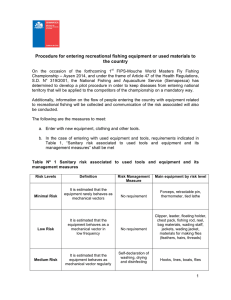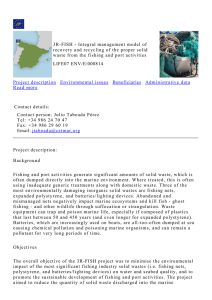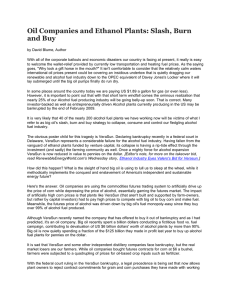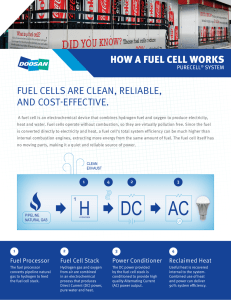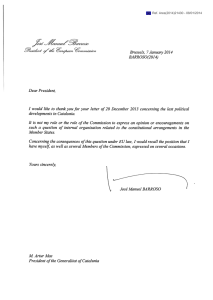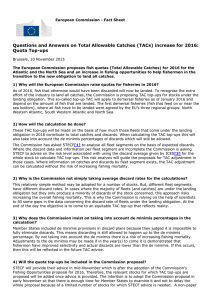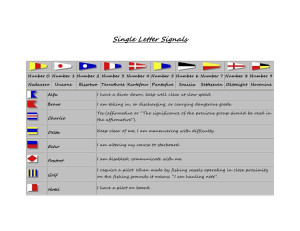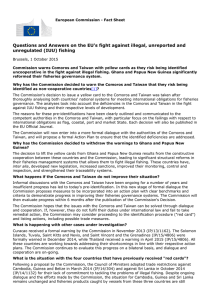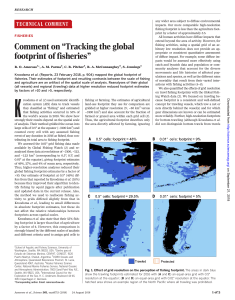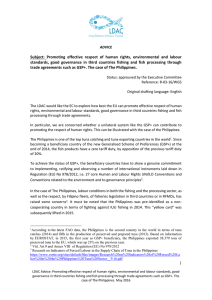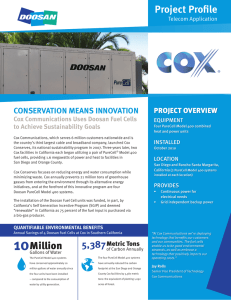integration of an acquisition system for studying the energy
Anuncio
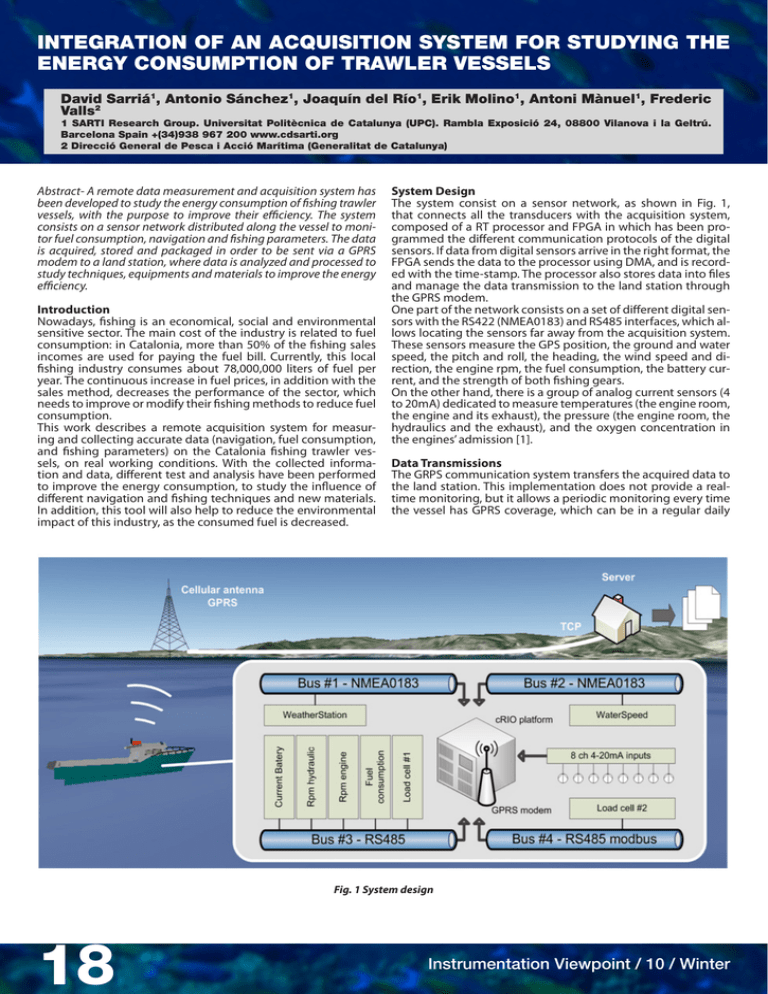
INTEGRATION OF AN ACQUISITION SYSTEM FOR STUDYING THE ENERGY CONSUMPTION OF TRAWLER VESSELS David Sarriá1, Antonio Sánchez1, Joaquín del Río1, Erik Molino1, Antoni Mànuel1, Frederic Valls2 1 SARTI Research Group. Universitat Politècnica de Catalunya (UPC). Rambla Exposició 24, 08800 Vilanova i la Geltrú. Barcelona Spain +(34)938 967 200 www.cdsarti.org 2 Direcció General de Pesca i Acció Marítima (Generalitat de Catalunya) Abstract- A remote data measurement and acquisition system has been developed to study the energy consumption of fishing trawler vessels, with the purpose to improve their efficiency. The system consists on a sensor network distributed along the vessel to monitor fuel consumption, navigation and fishing parameters. The data is acquired, stored and packaged in order to be sent via a GPRS modem to a land station, where data is analyzed and processed to study techniques, equipments and materials to improve the energy efficiency. Introduction Nowadays, fishing is an economical, social and environmental sensitive sector. The main cost of the industry is related to fuel consumption: in Catalonia, more than 50% of the fishing sales incomes are used for paying the fuel bill. Currently, this local fishing industry consumes about 78,000,000 liters of fuel per year. The continuous increase in fuel prices, in addition with the sales method, decreases the performance of the sector, which needs to improve or modify their fishing methods to reduce fuel consumption. This work describes a remote acquisition system for measuring and collecting accurate data (navigation, fuel consumption, and fishing parameters) on the Catalonia fishing trawler vessels, on real working conditions. With the collected information and data, different test and analysis have been performed to improve the energy consumption, to study the influence of different navigation and fishing techniques and new materials. In addition, this tool will also help to reduce the environmental impact of this industry, as the consumed fuel is decreased. System Design The system consist on a sensor network, as shown in Fig. 1, that connects all the transducers with the acquisition system, composed of a RT processor and FPGA in which has been programmed the different communication protocols of the digital sensors. If data from digital sensors arrive in the right format, the FPGA sends the data to the processor using DMA, and is recorded with the time-stamp. The processor also stores data into files and manage the data transmission to the land station through the GPRS modem. One part of the network consists on a set of different digital sensors with the RS422 (NMEA0183) and RS485 interfaces, which allows locating the sensors far away from the acquisition system. These sensors measure the GPS position, the ground and water speed, the pitch and roll, the heading, the wind speed and direction, the engine rpm, the fuel consumption, the battery current, and the strength of both fishing gears. On the other hand, there is a group of analog current sensors (4 to 20mA) dedicated to measure temperatures (the engine room, the engine and its exhaust), the pressure (the engine room, the hydraulics and the exhaust), and the oxygen concentration in the engines’ admission [1]. Data Transmissions The GRPS communication system transfers the acquired data to the land station. This implementation does not provide a realtime monitoring, but it allows a periodic monitoring every time the vessel has GPRS coverage, which can be in a regular daily Fig. 1 System design 18 Instrumentation Viewpoint / 10 / Winter Fig. 2 Acquisition system (down) Part of data from a trawler vessel basis. Although the GPRS speed is low [2], the system is able to send all queued data before the vessel reaches port. Results The system has been installed on five trawler vessels and different tests have been carried out to study the fuel consumption. Studies show that it is possible to reduce the fuel consumption if some specific technical actions are applied. Specifically, current tests shown that it is possible to reduce up to 29% of energy per day, which is the consequence of reducing 41% of fuel during the trawler fishing activity, and 16% due to an efficient navigation management. This improvement can represent, to a standard Catalonia fishing trawler, a save of up to 18,000 Euro per year, approximately a reduction of 120 tons on CO2 emissions [3]. Conclusions A robust and autonomous system for monitoring energy efficiency in trawler vessels has been designed. This system allows monitoring different navigation and fishing parameters related to the energy consumption during their fishing activities. Successful results were obtained thanks to the remote monitoring using the GPRS communication. This system has shown to be a good solution (technically and economical), also if no realtime data is required, GPRS is an economical solution for data Instrumental Viewpoint / 10 / Winter transmission. This acquisition system is currently in use by different trawlers of Catalonia, and the collected data is being used to study new techniques to reduce the energy consumption of these vessels. Acknowledgements The Project Desarrollo de un sistema autónomo de adquisición de datos para la mejora de la eficiencia energética de los buques de arrastre de la flota catalana is a joint work between Direcció General de Pesca i Acció Marítima, Departament d’Agricultura, Alimentació i Acció Rural Generalitat de Catalunya, Tragsatec, Col•legi d’Enginyers Navals i Oceanogràfics de Catalunya and the Technological Development Center Remote Acquisition and Data Processing Systems from Technical University of Catalonia (UPC). REFERENCES [1] D. Gerr, Boat Mechanical systems handbook, McGraw-Hill, 2009 [2] GPRS and 3G applications. New York, John Wiley & Sons, cop. 2001 [3] Millora de l’eficiència, la sostenibilitat i el benefici de la flota pesquera d’arrossegament catalana. Generlalitat de Catalunya, Feb 2010 19
